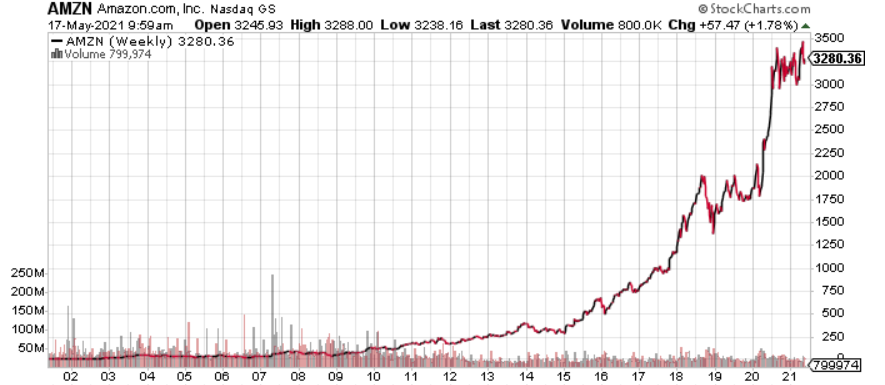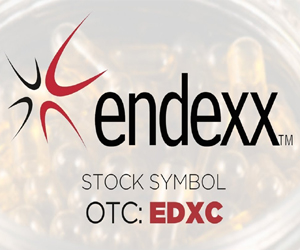Amazon.com, Inc.: AMZN Stock Is Reassuringly Expensive
Marijuana Business, Stocks, Finance, & Investing May 20, 2021 MJ Shareholders 0


Time to Look Beyond the Nominal Price of Shares
The answer to whether a stock is expensive or not has to do with a lot more than just its share price. There are many different valuation metrics—such as price-to-earnings ratio, price-to-book ratio, price/earnings-to-growth ratio, price-to-free-cash-flow ratio, etc.—that can be used to compare how expensive different stocks are.
But that hasn’t changed many people’s impressions that a stock trading at $50.00 is considerably “cheaper” than a stock priced at $500.00.
Obviously, if the $500.00 stock conducts a 10-for-one split, it would have a price of $50.00 per share. Indeed, many companies do split their stocks after a massive rally—in order to keep the nominal share price low.
There can be a variety of reasons behind companies’ stock-split decisions. But the fact that the average nominal share prices of common stocks trading on the New York Stock Exchange had remained constant at approximately $35.00 per share for decades due to stock splits is saying something.
There are even research papers (one was coauthored by a Nobel Prize-winning economist) that try to explain why U.S. companies want to maintain constant nominal prices for their shares, despite the enormous growth in their business. (Source: “The Nominal Share Price Puzzle,” American Economic Association, last accessed May 18, 2021.)
One thing I’d like to point out is that, in this day and age, investors don’t have to buy stocks in blocks of 100 shares. In fact, investors don’t even need to buy one full share at a time. A simple Internet search will show you quite a few brokerages that allow the trading of fractional shares.
My point is, we really shouldn’t come to a conclusion about whether a stock should be considered expensive or cheap based purely on the nominal price per share.
While many companies split their stocks after a huge bull run, some don’t. And that can result in share prices going well into the quadruple-digits.
Take a look at Amazon.com, Inc. (NASDAQ:AMZN), for instance. As the most dominant e-commerce company in many parts of the world, Amazon’s business has grown exponentially over the years—and so has the price of Amazon stock. Yet the last time the company split its stock was in 1999.
In other words, while AMZN stock went on to have an incredible rally, the company hasn’t split its stock in over two decades.
The result: Amazon stock now trades at more than $3,200 apiece.
Amazon.com, Inc. (NASDAQ:AMZN) Stock Chart

Chart courtesy of StockCharts.com
Here are some simple numbers to show you just how much the business had grown: In 2010, Amazon generated net sales of $34.2 billion. In 2020, its net sales came in at $386.1 billion. That’s an increase of 1,029%! (Source: “Amazon.com Announces Financial Results and CEO Transition,” Amazon.com, Inc., February 2, 2021.)
The COVID-19 pandemic resulted in a lot more people shopping online in 2020 than before. But even in 2021, Amazon’s growth momentum hasn’t been slowing down.
In the first quarter of 2021, Amazon’s net sales grew by another 44% year-over-year to $108.5 billion. And the bottom line improved even more. The company earned net income of $8.1 billion ($15.79 per share) in the first quarter, compared to $2.5 billion ($5.01 per share) in the year-ago period. (Source: “Amazon.com Announces First Quarter Results,” Amazon.com, Inc., April 29, 2021.)
For the second quarter, Amazon expects its net sales to be between $110.0 and $116.0 billion, which would translate to year-over-year growth of 24% to 30%.
There are quite a few fast-growing e-commerce businesses trading on the market, but Amazon is hands down the most dominant one in the developed world.
In his recent annual letter to shareholders, the company’s chief executive officer, Jeff Bezos, said there are now more than 200 million “Amazon Prime” members worldwide. (Source: “Letter to Shareholders,” Amazon.com, Inc., last accessed May 18, 2021.)
Analyst Take
I’m not saying AMZN stock is a bargain, but neither are the other fast-growing e-commerce stocks in today’s market. If you use the valuation metrics I mentioned earlier, you’ll see that Amazon stock isn’t expensive compared to its peers, but it’s not cheap, either.
I won’t speculate on when Amazon.com, Inc. will split its stock again. Just remember that the rally in AMZN stock over the years was backed by a booming business, and the quadruple-digit nominal price of its shares shouldn’t be a deterrent to investors.
MJ Shareholders
MJShareholders.com is the largest dedicated financial network and leading corporate communications firm serving the legal cannabis industry. Our network aims to connect public marijuana companies with these focused cannabis audiences across the US and Canada that are critical for growth: Short and long term cannabis investors Active funding sources Mainstream media Business leaders Cannabis consumers










No comments so far.
Be first to leave comment below.